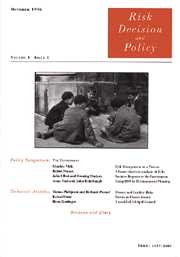No CrossRef data available.
Article contents
Risk perception and ethnicity
Published online by Cambridge University Press: 30 October 2001
Abstract
A Simplified Conjoint Expected Risk (SCER: Holtgrave and Weber, 1993) model-based approach was used to explore differences in the perceived risk of a variety of financial and health activities among Caucasians, African-Americans, Mexican-Americans, and Taiwanese-Americans. The SCER model postulates that the perceived risk of an activity is a function of five dimensions: the subjective probability of harm, benefit, and status quo, and the subjective expected harm and benefit. This model offers a framework in which to apply qualitative and quantitative approaches in order to identify and to assess the generality of ethnic group differences in the relative weight attached to probability and expected outcome information, the subjective valuation of probabilities and expected outcomes, and the perceived harms and benefits. Results demonstrated that the primary and most generalised locus of ethnic group perceived risk differences is the relative importance attached to probability and expected outcome information. As predicted, these differences tended to mirror ethnic group differences in orientation toward uncertainty. By decomposing differences in terms of the elements of the SCER model, these results demonstrate that risk communication and policy efforts in ethnically diverse countries should recognise the role of the relative weight attached to the likelihood and magnitude of harm and benefit in risk perception. Clarifying the bases for differences in perceived risk among ethnic groups may provide a better understanding of conflict over environmental or other issues and aid in the development of effective strategies for communicating about risk and negotiating solutions to important policy problems.
- Type
- Technical Article
- Information
- Copyright
- © Risk, Decision and Policy, 2001




